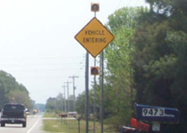CCTV | DMS | HAR | RWIS | VSL | Dynamic Speed Displays | Ramp Meters| Curve Warning Systems| Intelligent Work Zones | ICWS
Planning Guidance for the Installation and Use of Technology Devices for Transportation Operations and Maintenance
ENTERPRISE Transportation Pooled Fund Study
Intersection Conflict Warning Systems (ICWS)
For purposes of the ITS device guidance process, ICWS is defined as a traffic control device placed on major, minor or both roads of an intersection to provide drivers with a real-time dynamic warning of vehicles approaching the or waiting to enter the intersection. ICWS are typically installed to address crash factors associated with limited sight distance and poor gap selection at stop-controlled intersections.
Initial Guidance:
1) The planning guidance provides guidance for the use of an ICWS device, regardless of the device configuration. If an ICWS should be considered, the device configuration will be selected by the engineer. (Note: Design guidance for ICWS developed by ENTERPRISE and other relevant resources can be found at: Design and Evaluation Guidance for Intersection Conflict Warning Systems)
2) These guidelines do not mandate the use of ICWS. ICWS is one of several safety treatments that may be considered to improve safety at intersections.
3) ICWS #1 Intersections with High Crash Frequencies or Rates (Reactive Approach) and ICWS #2 Intersection Characteristics (Proactive Approach) may be used together or as stand-alone approaches for consideration of ICWS. Intersections meeting guideline criteria may not necessarily be selected for deployment of ICWS; these guidelines could be used to help agencies prioritize intersections for ICWS deployment.
4) To optimize the effectiveness of ICWS by reducing the likelihood of continuous alert activation, the following maximum ADT volumes should be considered:
- Major Road ADT typically does not exceed 12,000. (1)
- Minor Road ADT typically does not exceed 3,000. (1)
5) Engineering judgment should be used to assess potential implications that may result from installation of ICWS at candidate intersections.
References:
(1) Athey Creek Consultants. Design Guidance and Evaluation for Intersection Conflict Warning Systems. 2011.
Two (2) guidelines have been identified to capture the most common purposes and uses of ICWS. While there may be other uses for ICWS, the guidelines developed to date have focused on the following two. If you have suggestion of additional ICWS guidelines please contact us.
Intersections with High Crash Frequencies or Rates (Reactive Approach)
Copyright 2015 by the ENTERPRISE Program. All Rights Reserved.
